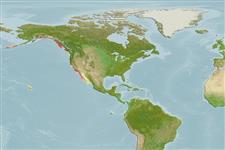Polymastia pacifica (Lambe, 1893)
Aggregated nipple sponge| Native range | All suitable habitat | Point map | Year 2050 |

|
| This map was computer-generated and has not yet been reviewed. |
| Polymastia pacifica AquaMaps Data sources: GBIF OBIS |
Hochladen Photos
Google Bild |
No photo available for this species.No drawings available for Polymastiidae.
Google Bild |
No photo available for this species.
Classification / Names Common names | Synonyms | CoL | ITIS | WoRMS
| Polymastiida | Polymastiidae
Environment: milieu / climate zone / depth range / distribution range Ökologie
; tiefenbereich 0 - 15 m (Ref. 865). Temperate
Verbreitung Länder | FAO Gebiete | Ecosystems | Vorkommen | Einführungen
Eastern Pacific: USA, Canada and Alaska.
Length at first maturity / Size / Gewicht / Alter
Maturity: Lm ? range ? - ? cm Max length : 2.0 cm H Männchen/unbestimmt; (Ref. 865)
White to yellow pale, breast-shaped individuals (1.2 cm at base and 2.0 cm in height) with single osculum; aggregations may cover 60-90 cm across. On rocks with sandy pockets at the very low intertidal zone (Ref. 865).
Life cycle and mating behavior Geschlechtsreife | Fortpflanzung | Ablaichen | Eier | Fecundity | Larven
Members of the class Demospongiae are hermaphroditic. Life cycle: The zygote develops into parenchymella larva (free-swimming) before settling down on a substrate where it grows into a young sponge.
Hauptreferenz
Referenzen | Koordinator | Partner
Bisby, F.A., M.A. Ruggiero, K.L. Wilson, M. Cachuela-Palacio, S.W. Kimani, Y.R. Roskov, A. Soulier-Perkins and J. van Hertum. 2005. (Ref. 19)
IUCN Rote Liste Status (Ref. 130435)
CITES Status (Ref. 108899)
Not Evaluated
CMS (Ref. 116361)
Not Evaluated
Bedrohung für Menschen
Nutzung durch Menschen
| FishSource |
Tools
Mehr Information
Alter/Größe
Wachstum
Länge-Gewicht
Länge-Länge
Morphologie
Larven
Dichte
Wachstum
Länge-Gewicht
Länge-Länge
Morphologie
Larven
Dichte
Internet Quellen
BHL | BOLD Systems | CISTI | DiscoverLife | FAO(Publication : search) | Fishipedia | GenBank (Genom, nucleotide) | GloBI | Gomexsi | Google Books | Google Scholar | Google | PubMed | Tree of Life | Wikipedia (Gehe zu, Suchen) | Zoological Record
Estimates based on models
Preferred temperature
(Ref. 115969): 6.1 - 14, mean 8.9 (based on 267 cells).
Preiskategorie
(Ref. 80766):
Unknown.


